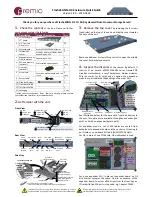
1-4
authentication. This solves the problem about IP address planning and allocation and proves to be
useful. For example, a service provider can allocate public IP addresses to broadband users only when
they access networks beyond the residential community network.
Layer 3 authentication
Layer 3 portal authentication is similar to direct authentication. However, in Layer-3 portal
authentication mode, Layer 3 forwarding devices can be present between the authentication client and
the access device.
Differences between Layer 3 and non-Layer 3 authentication modes
z
Networking mode
From this point of view, the difference between these two authentication modes lies in whether or not a
Layer 3 forwarding device can be present between the authentication client and the access device. The
former supports Layer 3 forwarding devices, while the latter does not.
z
User identifier
In Layer 3 authentication mode, a client is uniquely identified by an IP address. This is because the
mode supports Layer 3 forwarding devices between the authentication client and the access device but
the access device does not learn the MAC address of the authentication client. In non-Layer 3
authentication mode, a client is uniquely identified by the combination of its IP address and MAC
address because the access device can learn the MAC address of the authentication client.
Due to the above differences, when the MAC address of an authentication client remains the same but
the IP address changes, a new portal authentication will be triggered in Layer-3 authentication mode
but will not be triggered in non-Layer 3 authentication mode. In non-Layer 3 authentication mode, a new
portal authentication will be triggered only when both the MAC and IP address of the authentication
client are changed.
Portal Authentication Process
Direct authentication and Layer 3 authentication share the same authentication process, while
re-DHCP authentication has a different process because of the presence of two address allocation
procedures.
Summary of Contents for S5500-SI Series
Page 161: ...3 10 GigabitEthernet1 0 1 2 MANUAL...
Page 220: ...1 7 Clearing ARP entries from the ARP table may cause communication failures...
Page 331: ...1 7 1 1 ms 1 ms 1 ms 1 1 6 1 2 1 ms 1 ms 1 ms 1 1 4 1 3 1 ms 1 ms 1 ms 1 1 2 2 Trace complete...
Page 493: ...2 8...
Page 1111: ...1 10 Installing patches Installation completed and patches will continue to run after reboot...
















































